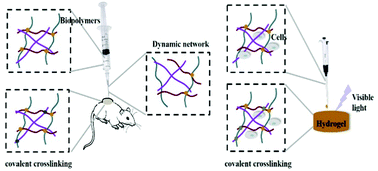Facile engineering of ECM-mimetic injectable dual crosslinking hydrogels with excellent mechanical resilience, tissue adhesion, and biocompatibility†
Abstract
Injectable hydrogels have aroused ever-increasing interest for their cell/biomaterial delivery ability through minimally invasive procedures. Nevertheless, it is still a challenge to simply fabricate natural biopolymer-based injectable hydrogels possessing satisfactory mechanical properties, bioadhesion, and cell delivery ability. Herein, we describe a facile dual crosslinking (DC) strategy for preparing extracellular matrix (ECM) mimetic hydrogels with desirable comprehensive performance. The chondroitin sulfate (CS)- and gelatin (Gel)-based single crosslinked (SC) hydrogels were first developed via reversible borate ester bonds, and further strengthened through the Michael-addition crosslinking reaction or visible-light initiated photopolymerization with thiol-containing polyethylene glycol (PEG) crosslinkers. The dynamic SC hydrogels showed good injectability, pH-sensitive gel–sol transformation, and self-adhesion ability to various biological tissues such as skin, liver, and intervertebral disc. The mechanically tough DC hydrogels displayed tunable stiffness, and resilience to compression load (up to 90% strain) owing to the effective energy dissipation mechanism. The formed DC hydrogels after subcutaneous injection well integrated with surrounding tissues and exhibited fast self-recovery properties. Moreover, the photoencapsulation of human mesenchymal stem cells (hMSCs) within the developed DC hydrogels was achieved and has been proved to be biocompatible, highlighting the great potential of the photopolymerized DC hydrogels in cell delivery and three-dimensional (3D) cell culture. This biomimetic, mechanically resilient, adhesive, and cytocompatible injectable DC hydrogel could serve as a promising candidate for tissue engineering.



 Please wait while we load your content...
Please wait while we load your content...